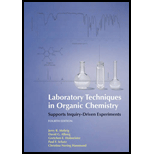
Concept explainers
Interpretation:
The more effective drying agent should be identified among
Concept introduction:
Drying agents are used to remove water from organic solvents. Mostly anhydrous drying agents are used that react with water to form insoluble hydrates in organic solvents and can be easily removed by filtration. Parameters that are considered to choose an effective drying agent are as follows:
- Capacity: The maximum number of moles of water molecules that can be trapped by a salt or drying agent defines its capacity.
- Efficiency: The amount of water left behind in the organic solvent after the drying process is called efficiency.
- Speed of removal of water: Time taken by the drying agent to form hydrate determines the speed of removal of water.
- Chemical inertness: Drying agents should be chemically inert that is it should not react with the organic solvent and the organic compounds dissolved in it.
Explanation of Solution
Among
Want to see more full solutions like this?
Chapter 11 Solutions
Laboratory Techniques in Organic Chemistry
- Answer each question and justify your answer by doing ALL of the following: Identify the type of substance and important interpartide force(s) for both substances. Explain how you know (substances and forces). For each molecular substance, fully justify how you know if it is polar or nonpolar. Provide a Lewis structure, a geometry sketch, calculation of AEN| values, and a discussion of symmetry. Identify which of the two substances has stronger interparticle forces. If they have the same type of interparticle force, explain how you know which is stronger. Answer the question by connecting the property asked about to strength of interparticle forces. Use complete sentences, write all words out (no abbreviations) and be specific and complete with all explanations. Do not refer to any actual data.arrow_forward50.00 mL of a solution containing 0.15 M CH2 (CO2 H)2 and 0.020 M MnSO4 2. Calculate the mass of manganous sulfate monohydrate required (manganese sulfate is available only in the monohydrate form, MnSO4·H2O, which means that within every MnSO4 unit cell, there is one water molecule present; the mass of the water must therefore be included in the calculation). Answer watch your sig figs.arrow_forwardCalculate the temporary and total hardness of a water sample containing Mg(HCO3)2= 73mg/L, Ca(HCO3)2= 162mg/L, M9C12= 95mg/L, CaSO4=136mg/L.arrow_forward
- Calculate the temporary and permanent hardness of water sample containing Mg(HCO3)2= 7.3mg/L, Ca(HCO3)2= 16.2mg/L, MgC12= 9.5mg/L, CaSO4=13.6mg/L).arrow_forward50.00 mL of a solution containing 0.15 M CH2 (CO2 H)2 and 0.020 M MnSO4·H2O Calculate the mass of manganous sulfate monohydrate required (manganese sulfate is available only in the monohydrate form, MnSO4H2O, which means that within every MnSO4 unit cell, there is one water molecule present; the mass of the water must therefore be included in the calculation).arrow_forwardWhy do Sedimentation and filtration is important in water treatment?Is a period of timeimportant in water purification?arrow_forward
- The volume of the mixture prepared by taking 1.158 moles and 0.842 moles of water and ethanol, respectively, at 25 ° C was measured as 68.16 cm ^ 3. Interpret the result by finding the volume change during the preparation of the mixture since the densities at 25 ° C for pure water and atanol are given as 0.9970 g / cm ^ 3 and 0.7852 g / cm ^ 3, respectively.arrow_forward(b) Calculate the quantity of lime and soda required for softening one million litre of thefollowing sample of water. If the purities of lime and soda are 80% and 85%respectively. The impurities are Silica = 75 mg/lit. MgCl2 = 19 mg/lit. MgSO4 = 30mg/lit. CaSO4 = 68 mg/lit. MgCO3 = 884 mg/lit. CaCO3 = 120 mg/lit.arrow_forwardThe density of methylene chloride is 1.33 g/mL. A mixture of an organic acid, an organic base and a neutral organic compounds is dissolved in methylene chloride as the first step in a liquid-liquid extraction. Which layer is the methylene chloride? - upper layer lower layerarrow_forward
- Distinguish between Chemiluminescence and Triboluminescence and give an example of each.arrow_forwardCalculate the quantity of lime and soda required for softening one million litre of the following sample of water. If the purities of lime and soda are 80% and 85% respectively. The impurities are Silica mg/lit. CaSO4 = 68 mg/lit. MgCO3 = 884 mg/lit. CaCO3 = 120 mg/lit. 75 mg/lit. MgCl2 = 19 mg/lit. MgSO4 = 30 %3D %3Darrow_forwardcalculate the solubility of ca3(po4)2 in water ksp = 2.07 x 10-33arrow_forward
 Chemistry: The Molecular ScienceChemistryISBN:9781285199047Author:John W. Moore, Conrad L. StanitskiPublisher:Cengage Learning
Chemistry: The Molecular ScienceChemistryISBN:9781285199047Author:John W. Moore, Conrad L. StanitskiPublisher:Cengage Learning
